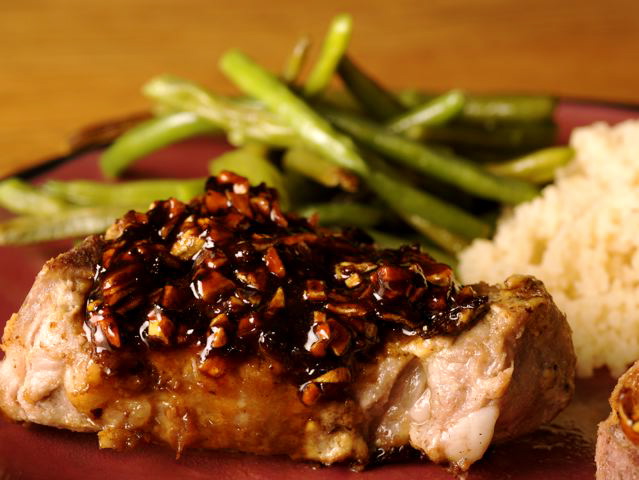
reference-image, l
(article, Nadine Fiedler)
[%pageBreakSettings nobreak=true] Salt is everywhere, revered by cooks worldwide since ancient times. We are surrounded by an ocean of salt. We need salt (admittedly in minuscule portions) to survive. [[block(sidebar). h1.Featured recipes]] But if you follow a low-sodium diet to fend off hypertension, as I do, you have to shun salt. As a devoted cook, I've spent the past seven years learning how to make food that's still delicious without much salt. And I've succeeded in lowering my blood pressure, too. When you don't have salt to spark your palate, you have to rely on other deep flavors to make food appealing. Over time, salt-free eaters will develop the ability to taste food more keenly. And going salt-free often means eating out less — not to mention, eating less or no processed, sodium-rich food — which means a better diet overall. Because of this, low-sodium cooking need not be a loss, but a gain. A low-sodium repertoire relies on herbs, spices, and aromatics, as well as deeply flavored liquids such as wine, stock, and citrus juices. A pepper grinder and pepper blends are essential. Tomato products help build flavors, and onion and garlic provide a base for many dishes. Produce in season always tastes richer, too, so buy what you like during its peak. h3. Shopping for herbs and spices Herbs and spices are key to creating satisfying tastes. Buy high-quality, salt-free herbs and spices at a specialty shop like Penzeys or in bulk at a store where the product moves quickly. Freshness and variety are crucial. If you can, either buy or grow your own fresh herbs, which pack an amazing amount of flavor. [%image reference-image float=right width=400 caption="Try lamb chops with pomegranate molasses for a less salty but still flavorful meal."] Stop and sniff while shopping. Buy what pleases you, even if it may be unfamiliar. Many spices and herbs come with recommendations for use, and that's a great place to start. But you'll find that as you learn the flavors, you become more comfortable improvising. Penzeys carries a few spice blends, such as Sunny Spain and Mural of Flavor, that include citric acid, which makes the blend tingle on your palate the same way salt does. Several other bottled brands offer blends using typical Italian, Mexican, Thai, and Chinese spices, and these make it easy to perk up dishes from those cuisines. h3. Cooking with herbs, spices, and aromatics In the kitchen, start with a bit of spice, then taste. A dish without salt will require much more seasoning in the way of herbs and spices, so don't be shy about shaking it in, in a big way. Keep tasting so you know when to stop. A little bit over the top is better than bland. Toasting can really enhance certain ingredients, including cumin seeds and dried chile peppers. (Toast the cumin seeds in a small, dry skillet, and the peppers in the oven.) Chili and other dishes that use these ingredients will taste much more intense if you take this step. Experiment with other dry seeds and powdered spices, such as mustard seeds. If you have the patience — and low-sodium cooking is naturally a bit slow — it's nice to grate your own nutmeg. (A Microplane grater works wonderfully for this.) Cardamom tastes more lively when you smash the seed pods, remove the seeds, and grind them yourself, either in a mortar and pestle or in a small propeller grinder. The aroma is reward itself. When I start a dish with onions, I always cook them until they're brown (but not burned), creating a much more savory base for the dish. Garlic also provides richness that can't be beat, so I always add a lot when I'm using it. [[block(sidebar). h1. Marion Nestle on salt Recently in a couple of her San Francisco Chronicle columns, nutrition expert Marion Nestle addressed salt and low-sodium diets. Nestle railed against the high salt content in processed foods, calling high-salt foods in America "the default." "About 80 percent of dietary salt is added to processed, restaurant, fast and catered foods," she writes. Bottom line: Cook your own food, so you can control the salt content. ]] After a dish is done, I like to reduce any leftover cooking liquids to intensify their flavors. h3. Working from recipes If you're thinking about adapting a recipe, think about whether the dish relies on salt for its flavor. If it does, that's not a good dish to adapt. I find that most Asian cuisines are sodium-heavy, relying on soy sauce, fish sauce, or salty curry pastes, so they're almost impossible to cook without sodium. But in other cuisines, start by leaving out the salt. Taste the dish as it cooks, and you may find that you want to boost the flavor with something like more spice. Try sprinkling it in until you're satisfied. When I first changed my diet, I was sure my favorite chicken soup (Mom's!) would taste like dishwater without salt. And it did at first, until I learned to really amp up the dill and add more celery, carrots, parsnips, and parsley. All these flavors compensated for the lack of salt. In the end, I think my version is as flavorful and soul-satisfying as Mom's. p(bio). [/mix/dinner_guests?author=4899 'Nadine Fiedler'] is a writer and editor in Portland, Oregon.

reference-image, l